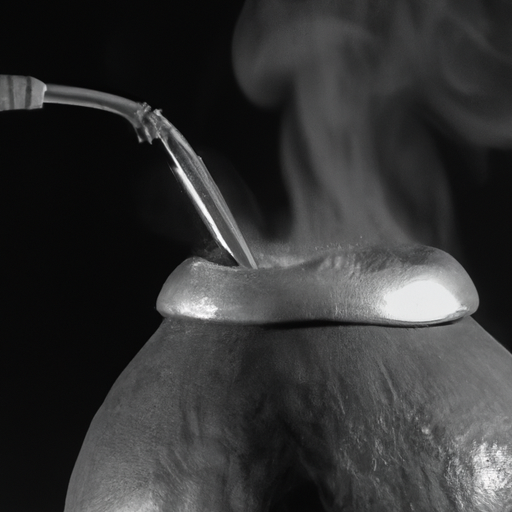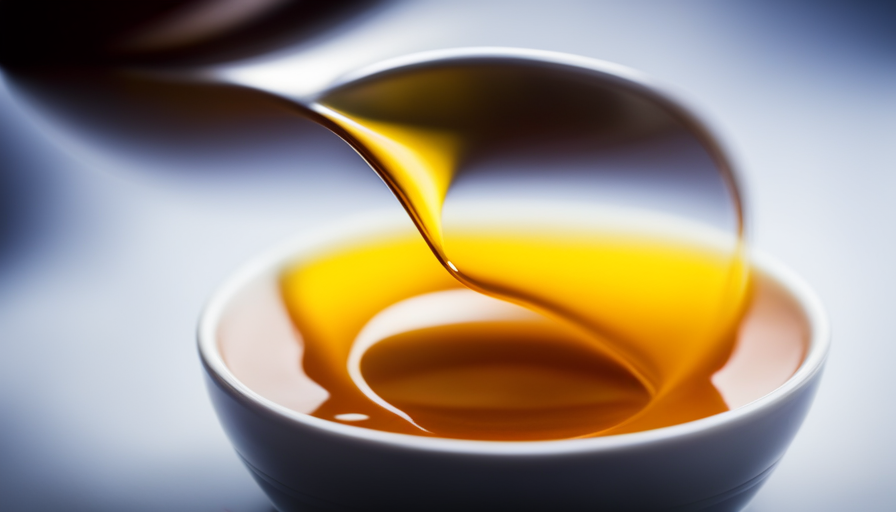Ah, the inviting and cozy scent of a newly made turmeric tea. It’s among my favorite drinks when I’m looking for something calming and nourishing. Yet, have you ever thought about its actual flavor? Does it taste bitter, heated, or perhaps sweet?
Well, in this article, I’ll take you on a sensory journey to explore the flavor profile of turmeric tea.
Turmeric is a spice that has been used for centuries in Ayurvedic medicine and culinary traditions. It’s known for its bright yellow color and earthy aroma. When infused with hot water to make tea, turmeric releases a complex blend of flavors that can range from slightly bitter and pungent to slightly sweet and floral.
The taste of turmeric tea can also be influenced by other ingredients such as ginger, honey, lemon juice, or black pepper. So let’s dive into the nuances of this ancient brew and discover its unique taste!
Key Takeaways
- Turmeric tea can taste slightly bitter and pungent to slightly sweet and floral, depending on the ingredients added.
- Curcumin, the chemical compound responsible for turmeric’s distinctive yellow-orange hue, also gives it an earthy and slightly bitter flavor.
- Adding black pepper to turmeric tea can enhance its taste by up to 200%, while other ingredients like lemon juice, honey, or different spices can tweak its taste.
- Pairing turmeric tea with the right flavors is important to enhance its taste, and using high-quality loose leaf tea and tea accessories can result in better overall flavor.
What is Turmeric Tea?
You’re probably wondering what turmeric tea tastes like, but first, let’s define what it is. Turmeric tea is a warm beverage made from boiling water and turmeric root or powder. It has been consumed for centuries in India and other parts of Asia due to its numerous health benefits. Some people add honey, ginger, lemon, or black pepper to enhance the flavor.
Turmeric tea benefits are impressive as it contains curcumin, a chemical compound with anti-inflammatory properties that can help reduce pain and inflammation in the body. Other potential benefits include boosting the immune system, improving digestion, and reducing the risk of chronic diseases such as Alzheimer’s and cancer.
There are many turmeric tea recipes available online that cater to different tastes. Some people prefer a spicier version by adding more ginger or black pepper while others opt for a sweeter taste by adding honey or cinnamon.
Now that you know about the health benefits and various ways to prepare turmeric tea, let’s explore its flavor profile.
The Flavor Profile of Turmeric
The flavor of turmeric is often described as earthy and slightly bitter, but did you know that adding a pinch of black pepper can enhance its taste by up to 200%?
This golden spice has a unique taste profile that can add depth and complexity to any dish or beverage. When brewed into tea, turmeric imparts a warm and comforting flavor with hints of ginger and citrus.
Turmeric’s flavor is not overpowering, making it an ideal addition to many different types of tea blends. It pairs well with other warming spices like cinnamon, nutmeg, and cardamom. Additionally, the natural sweetness of honey or maple syrup can balance out any bitterness in the turmeric for a smoother taste.
So when sipping on a cup of turmeric tea, expect to experience a warm and comforting drink with subtle notes of citrus and ginger. The earthiness from the turmeric will also shine through beautifully.
But have you ever wondered what makes this spice so flavorful? Let’s explore the role of curcumin in the taste of turmeric tea.
The Role of Curcumin in the Taste of Turmeric Tea
Adding a pinch of black pepper to your turmeric tea can transport your taste buds on a flavorful journey, as the curcumin in turmeric plays a crucial role in its warm and comforting taste profile. Curcumin is responsible for the earthy and slightly bitter flavor of turmeric, which can be intensified or subdued depending on how it’s extracted from the root.
This compound also gives the tea its distinctive yellow-orange hue that makes it so visually appealing. If you’re looking to maximize the curcumin content in your turmeric tea, then boiling fresh or ground turmeric root with black pepper and some healthy fat like coconut milk is your best bet. The heat helps release more curcumin from the plant material while black pepper contains piperine that enhances its bioavailability.
Adding some coconut oil or ghee to the mix further boosts absorption since curcumin is fat-soluble. Once you strain out any solids, you’ll be left with a fragrant and flavorful cup of golden liquid that’s loaded with antioxidants and anti-inflammatory compounds.
Here are four ways to tweak your turmeric tea recipe based on your personal preferences:
- Add a squeeze of lemon juice for some tanginess
- Use honey or maple syrup instead of sugar for sweetness
- Experiment with different spices like cinnamon or ginger to add depth
- Steep some loose leaf tea like green or black along with turmeric for added complexity
Now that we’ve explored how curcumin affects the taste of turmeric tea, let’s dive into its many health benefits!
Health Benefits of Turmeric Tea
Get ready to discover the incredible health benefits of sipping on a warm cup of turmeric tea. Turmeric has been used for centuries in traditional medicine and is well known for its anti-inflammatory properties, which can help alleviate pain and swelling throughout the body.
Additionally, turmeric contains compounds that may boost brain function and reduce the risk of certain chronic diseases. Not only does turmeric offer numerous health benefits, but it also makes for a delicious and comforting beverage.
There are many different turmeric tea recipes to choose from, including variations with ginger, honey, lemon, and cinnamon. Each recipe adds its own unique flavor profile to the drink while still providing all of the same wonderful health benefits.
If you’re looking to improve your overall well-being in an easy and enjoyable way, then consider adding turmeric tea to your daily routine. Now that we’ve talked about some of its amazing health benefits, let’s move on to exploring different ways to prepare this delicious beverage.
Different Ways to Prepare Turmeric Tea
Are you tired of drinking the same old tea every day? Spice up your routine with these creative ways to prepare turmeric tea and reap all of its incredible health benefits.
Turmeric tea variations are endless, from a simple recipe of boiling water and turmeric powder, to adding ginger, honey, or lemon for extra flavor. You can also experiment with milk-based recipes like golden milk or chai latte, which include other spices like cinnamon and cardamom.
It’s important to note that the best time to drink turmeric tea is in the morning on an empty stomach or before bed for better digestion and relaxation. The warm and soothing aroma of turmeric combined with other ingredients will calm your senses and help you unwind after a busy day. Plus, consuming it regularly can boost your immune system, reduce inflammation, aid in weight loss and promote healthy skin.
Pairing turmeric tea with other flavors is easy! You can add mint leaves for a refreshing twist, black pepper for increased absorption of curcumin (the active ingredient in turmeric), or even fruit juices like orange or grapefruit for a tangy taste.
So why not try out these delicious variations today? Your taste buds (and body) will thank you!
Pairing Turmeric Tea with Other Flavors
Turmeric tea is like a blank canvas just waiting for the perfect flavor pairing to create a masterpiece in your taste buds. While turmeric has a distinct, earthy flavor that some find bitter or pungent on its own, it also pairs beautifully with other flavors.
One popular combination is ginger and honey, which adds sweetness and a touch of spice to balance out the turmeric’s bitterness. Another great option is adding lemon or orange zest for a citrusy twist.
When it comes to flavor combinations, there are endless possibilities for turmeric tea. A few other ideas include adding cinnamon or cardamom for warm, cozy notes; mint leaves for freshness; or even coconut milk and vanilla extract for a creamy treat. Don’t be afraid to experiment with different ingredients until you find your perfect blend.
To enhance the experience of drinking turmeric tea, consider investing in some tea accessories like an infuser or strainer to make brewing easier and mess-free. Additionally, using high-quality loose leaf tea can result in better overall flavor than using pre-packaged bags.
With the right combination of flavors and tools at your disposal, sipping on turmeric tea can become a delicious ritual that you look forward to every day.
Now that we’ve explored some flavor pairing options and ways to elevate your brewing process with tea accessories, let’s move onto tips for brewing the perfect cup of turmeric tea.
Tips for Brewing the Perfect Cup of Turmeric Tea
I hope you’re feeling adventurous because we’re about to dive into the world of brewing the perfect cup of turmeric tea! But before we get started, let’s talk about how important it is to pair your turmeric tea with the right flavors. As I mentioned earlier, turmeric has a strong and unique flavor that can be enhanced by certain ingredients such as ginger, cinnamon, and honey. These flavors really bring out the best in turmeric tea and make for a truly delicious experience.
Now onto brewing techniques! The key to brewing a great cup of turmeric tea is to not overdo it with the amount of turmeric you use. Too much turmeric can result in an overpowering taste that can be quite unpleasant. Instead, try using just a pinch or two per cup, and adjust according to your preference. If you want a stronger taste, simply add more turmeric.
To help you brew the perfect cup every time, I’ve created this handy table below that lists some recommended additives along with their benefits:
| Additive | Benefits |
|---|---|
| Ginger | Helps with digestion and adds warmth to the tea |
| Cinnamon | Adds sweetness without adding sugar |
| Honey | Provides natural sweetness while also offering anti-inflammatory properties |
With these tips in mind, you’ll be able to enjoy a warm and flavorful cup of turmeric tea in no time! And if you’re wondering where to find this amazing beverage, don’t worry – we’ll cover that next.
Where to Find Turmeric Tea
If you’re on the hunt for a cozy and aromatic beverage, look no further than the shelves of your local health food store or online retailers. Turmeric tea is becoming increasingly popular, and it’s easy to see why. Not only does this tea taste delicious, but it also offers numerous health benefits.
When searching for turmeric tea, there are several brands to choose from. Some of the most popular include Yogi Tea, Traditional Medicinals, Pukka Herbs, and The Republic of Tea. Each brand has its unique blend of ingredients and flavor profile, so be sure to try a few different ones to find your favorite.
Turmeric tea benefits go far beyond just satisfying your taste buds. This tea is packed with antioxidants and anti-inflammatory properties that can help reduce inflammation in the body and boost overall health. Plus, turmeric has been shown to improve brain function, lower the risk of heart disease, and even potentially prevent certain types of cancer.
Looking for inspiration on how to enjoy your turmeric tea? Check out our next section on delicious turmeric tea recipes!
Turmeric Tea Recipes
I absolutely adore turmeric tea, and I love experimenting with different recipes.
One classic recipe that I always go back to is a simple blend of turmeric, black pepper, and honey in hot water.
For those who want a little extra kick, I highly recommend trying out a combination of turmeric and ginger tea.
And if you’re feeling indulgent, why not try making a delicious turmeric latte?
There are so many options when it comes to this versatile spice, and I can’t wait to explore more of them!
Classic Turmeric Tea
You’ll love the warm and earthy flavor of classic turmeric tea, with a subtle hint of sweetness and spice that will awaken your taste buds. The spice level is just right, not too overwhelming but enough to give you a kick.
As you take your first sip, you’ll notice the aromatic notes of turmeric fill your senses, transporting you to an exotic land.
The beauty of classic turmeric tea lies in its simplicity – it’s easy to make and doesn’t require many ingredients. However, if you want to add more depth to the flavor profile, try adding some ginger for a spicy twist.
Speaking of ginger, let me tell you about my favorite variation – turmeric and ginger tea!
Turmeric and Ginger Tea
Get ready to enjoy a delicious and healthy cup of turmeric and ginger tea! This dynamic duo has been used for centuries in traditional medicine to treat a variety of ailments.
The combination of turmeric and ginger is not only aromatic but also incredibly flavorful. The turmeric and ginger pairing offers many benefits, including reducing inflammation in the body, promoting healthy digestion, enhancing immune function, and providing antioxidant support.
Incorporating this tea into your daily routine can help improve overall health and wellness. Now, let’s move on to the next section where we’ll explore another tasty way to incorporate turmeric into your diet – the turmeric latte!
Turmeric Latte
Indulge in a creamy and comforting turmeric latte that’ll satisfy your caffeine fix and offer a range of health benefits. This delicious drink is made by blending hot milk with turmeric powder, cinnamon, ginger, black pepper, and honey. It’s warm, fragrant, and has a subtle sweetness that makes it perfect for any time of day.
Here are some reasons why you should give this turmeric milkshake a try:
- Turmeric contains curcumin, which has powerful anti-inflammatory properties.
- Cinnamon can help regulate blood sugar levels.
- Ginger aids in digestion and helps relieve nausea.
- Black pepper enhances the bioavailability of curcumin in turmeric.
Overall, this creamy latte provides not only an enjoyable taste experience but also many potential health benefits. Give it a try next time you’re looking for something warm and cozy to sip on!
Frequently Asked Questions
Is turmeric tea safe to drink if I have certain medical conditions?
As the saying goes, "an ounce of prevention is worth a pound of cure."When it comes to turmeric tea and medical considerations, it’s important to be cautious.
While this golden elixir has been used for centuries in Ayurvedic medicine for its anti-inflammatory properties, it may not be suitable for everyone. If you have certain medical conditions, such as gallbladder problems or are taking blood thinners, you should consult with your doctor before consuming turmeric tea.
Potential side effects include upset stomach and diarrhea if consumed in large amounts. However, when consumed in moderation and with caution, turmeric tea can provide a flavorful and aromatic addition to your daily routine while also potentially providing health benefits.
Can I add milk or sweeteners to my turmeric tea?
When it comes to adding milk or sweetener to turmeric tea, the decision is entirely up to personal preference. Some people enjoy the natural earthy flavor of turmeric and prefer not to add anything extra. However, for those who find the taste too strong or bitter, a splash of milk or a sweetener like honey can help balance out the flavors.
Personally, I like to add a little bit of almond milk and a drizzle of maple syrup to my turmeric tea for added creaminess and sweetness. Overall, the flavor profile of turmeric tea is unique and may take some getting used to, but with a few simple additions, it can be transformed into a delightful and soothing beverage.
How often should I drink turmeric tea to reap its health benefits?
Did you know that consuming turmeric tea regularly can improve your overall health and wellness? According to a study published in the Journal of Medicinal Food, drinking turmeric tea daily for six weeks can significantly reduce inflammation markers in the body.
To reap the benefits of this golden elixir, it’s recommended to drink 1-2 cups of turmeric tea per day. However, it’s important to note that excessive consumption may lead to gastrointestinal issues. So, find a frequency that works for you and enjoy the anti-inflammatory and antioxidant properties found in each cup of turmeric tea!
Can I use fresh turmeric root instead of ground turmeric to make tea?
Yes, you can definitely use fresh turmeric root to make tea instead of ground turmeric. In fact, using fresh turmeric may even provide additional health benefits beyond the taste. Fresh turmeric root contains higher levels of curcumin, which is the active ingredient that provides anti-inflammatory and antioxidant properties.
Incorporating fresh turmeric into your tea routine may also help improve digestion and boost immune function. So, if you have access to fresh turmeric root, don’t hesitate to give it a try in your next cup of tea!
Does turmeric tea have caffeine?
Did you know that turmeric has been used for thousands of years in Ayurvedic medicine for its anti-inflammatory properties?
Now, let’s talk about the caffeine content of turmeric tea. The good news is that there’s no caffeine in turmeric tea, making it a great alternative to coffee or black tea.
As for the taste, it can vary depending on how it’s prepared – some people find it earthy and slightly bitter while others describe it as spicy and warming. I personally love adding a squeeze of lemon and a drizzle of honey to enhance the flavor.
Regardless of taste preferences, turmeric tea is packed with health benefits such as reducing inflammation, boosting immunity, and improving digestion.
So next time you’re looking for a healthy beverage option, give turmeric tea a try!
Conclusion
In conclusion, turmeric tea is a flavorful and aromatic brew that offers numerous health benefits. Its unique taste can be described as warm, earthy, and slightly bitter. The key component responsible for its distinct flavor is curcumin, which also provides the tea with its anti-inflammatory properties.
Drinking turmeric tea is not only a treat for your taste buds but also a wellness ritual for your body. It’s like savoring a steaming cup of sunshine on a cold winter day, where every sip warms you up from within and fills you with vitality.
So why not try brewing yourself a cup of this golden elixir today and see how it brightens up your day!










